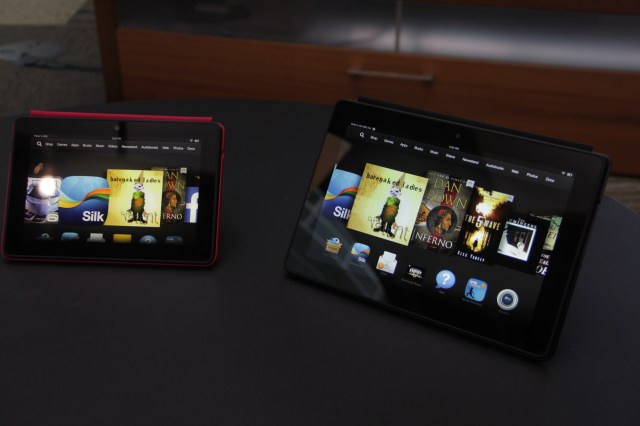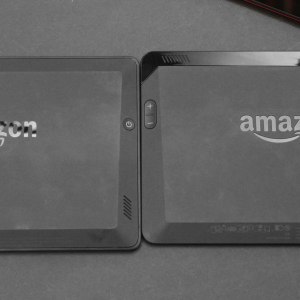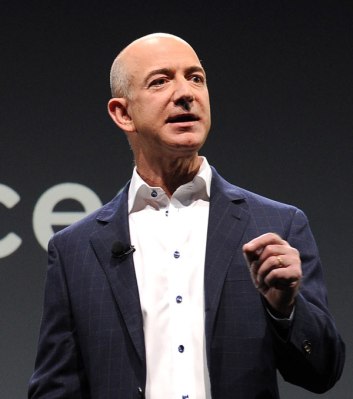I drive a rental car through the rich gray green of overwatered, undersunned Seattle suburbs that border a city rising like a prize at the end of the road. The trees are the color of dried oregano, the air dense and wet. I’m going into Amazon country to meet Jeff Bezos, the king of this lush land (these days the old king, Bill Gates, is resting comfortably by the water saving the world).
It’s my first time here – I’ve been covering Amazon products for years and our household could probably be re-papered in Amazon-branded cardboard boxes – and I’m excited to make the man’s acquaintance. I’m led into a room by an assistant and there he is, impeccably dressed in close-fitting jeans, a dark button down, and wingtips that looked like they came out of the closet of Rick Deckard, Blade Runner. In preparation I asked around to see what folks had experienced while interviewing him. One reporter noted that he rarely wore belts. This time he was wearing a belt.
“They were kind enough save a few surprises that I can share,” he says, offering me a seat in a sunny, well-appointed meeting room with a whiteboard and a television. He’s really excited. It’s rare for him sit down with media like this. Usually he launches on stage and this is a unique opportunity to hear the man who shipped a million (plus) books.
“A third leg of our strategy and vision is going to reveal itself,” he says.
I was ready. He got up to scribble on the board like a professor in a catch-up session. He outlined the three legs of Amazon’s success – the keys to the kingdom in blue dry-erase ink. “We sell premium products at non-premium prices. We make money when people use our devices, not when they buy them. I see people with five-year-old kindle ereaders and I don’t have to be discouraged by that. They don’t have to be on the upgrade treadmill,” he says.
“The third one, which is new, is the intersection of customer delight and deep integration throughout the entire stack. One of the hardest and coolest things that you might do occurs right here. When I talk about the entire stack I’m thinking about hardware at the bottom, the OS, the key apps, cloud, and even services on top of that.”
That’s when the new products came out. He was here to show me the new Kindle Fire HDX as well as the new Kindle Fire HD. Like a proud parent he pulls them out of a leather satchel and places them, one after the other, in front of me. I had seen them a few minutes before but the way he reverently handled gave them fresh meaning. This was a father showing off his kids and he was duly proud. He wanted to show me what he was talking about when he spoke of starting at the bottom and working through the stack.

He picks up a Kindle HDX and swipes down from the top. A list of icons appears. There was a new, unfamiliar one that looked like a little life-preserver.
“We’ll click on this button here,” he says. “It’s called Mayday. What do you think that will do?”
A little window pops and a smiling Amazon tech appears. “Hi, I’m Dylan. I see you activated Mayday. How can I help you?”
It was a canned demo, to be sure – Dylan definitely knew his boss was about to call – but it was a fascinatingly human moment. Dylan kept smiling throughout.
“Hi Dylan, it’s Jeff here, I’m going to show off Mayday,” says Bezos. “One of the things happening with these devices is they’re sophisticated enough and they have quite a number of settings.”
He calls Mayday “on-device tech support.”
“Dylan, first of all, move yourself on the screen. Maybe move yourself onto the upper right hand corner for a second.”
Dylan’s window moves into a corner.
“What’s a hot game that everybody’s buying these days?” he asks.
Dylan brings up Angry Birds Star Wars II. Bezos, the guy who runs all this stuff, needed a little help picking a game.
“We think mostly people will want to be taught how to do things but we can show them as well. This service is 24/7, it’s free, and we set an internal goal of answering Mayday sessions in 15 seconds or less.”
“Doing this requires a lot of heavy lifting.”
 Bezos says he’ll be ready for Christmas morning when support usage spikes. He talks about how difficult it is to do tech support over the phone and how hard it is to get this thing to work. There was a concerted effort to build this from the core of the device, all the way down to the packets transmitted to ensure a good connection.
Bezos says he’ll be ready for Christmas morning when support usage spikes. He talks about how difficult it is to do tech support over the phone and how hard it is to get this thing to work. There was a concerted effort to build this from the core of the device, all the way down to the packets transmitted to ensure a good connection.
“Are we in charge of our devices or are our devices in charge of us?” he asks. With Mayday he hopes to put control back into the hands of the users.
“What are you guys now? Are you a hardware company now or services company,” I ask.
“Yes. People always ask me this one. ‘Are you a technology company or a reseller?’ And I would say yes. We’re a technology company and we use technology and everything else to help our customers.”
He says Amazon is full of talent. “This stuff comes from everywhere. We have people from our video, music team, or ebooks team, Lab 126 in Menlo Park. We have people writing software in many places.”
“Good hardware is hard. Getting that hardware to that weight, getting 11 hours of battery life, 17 hours of reading. These things were very hard. But the software is very hard, too.”
He laughs. He’s got a great laugh. I can imagine it booming through an Amazon warehouse somewhere, making someone flinch: Bezos is in the room.
“There’s really nothing easy in that whole stack. Hardware is hard, the cloud integration is super hard, layer services on top like tech support, nobodies attempted to do that.”
“How would feel if you never had to ship a CD or a book again?” I ask. I wanted to know if he would be happy never having to ship another physical box.
“I think that’s going to take a very long time. What we’re finding right now is that even our heaviest Kindle ebook customers are still buying physical books. We’re seeing a lot of vinyl sales.”
“Clearly if you look far enough into the future, I don’t know how many years, it’s very rapidly going towards digital items. Our point of view is that we did the very best we can in the physical media products and the digital media products and our customers choose what they like best.”
“But you’re a guy who has a bunch of warehouses. Would you be happy on that day?” I ask.
“To take it out of philosophical into the practical, we sell a lot of shoes and diapers. For Amazon, it’s not just about media products. The vast percentage of what we do is non-media products. It’s mixers, diapers, and shoes. It’s stuff you can’t download. Even the very best 3D printers can’t print a tablet.”
“I think 3D printing is one of those incredibly exciting arenas. We’ll have to see how it interacts with Amazon but it’s too early to see. We have Createspace to make books and we do similar things for music CDs,” he says.
“In terms of local, is anything changing there?”
“We’ve been doing Amazon Fresh in Seattle for a number of years and we recently launched it in Los Angeles. We’re excited about it. It’s still super early. It’s an entirely new last mile logistical chain, even upstream from that there are quite a few new logistics. That’s why we experimented with it in Seattle for so long.”
“It’s so cold here, so you can keep the food fresh,” I quip.
That laugh again.
“But you gotta keep it dry,” he says.

Who is Jeff Bezos? I try to break the ice at one point by saying my wife is having trouble with her diaper subscription. We get a box of diapers monthly through Amazon and she’s been getting them in the middle of the month. I ask if he could handle some customer support and get that changed.
“I’m a good switchboard operator. I know exactly who to call,” he says. The answer struck me as being surprisingly simple and accurate. Amazon has 97,000 employees and Bezos is at the center, making calls. His focus is constant contact – from emails that offer discounts on items you drunk browsed idly one Friday (the Canon G15 pops up in my mailbox every few days simply because I looked it once, long ago. Tellingly, I don’t even care about the intrusion.)
Amazon isn’t a tech company or a reseller or a services company. It’s a centralized repository for commerce. Products flow in and leave with as little friction as possible. When you have a problem you simply write a few lines and your return is processed. When your Kindle breaks, you press a button and Dylan pops into your world and helps you out. When something slips, Bezos knows how to route around the damage.
As I leave the appointment, I think about getting some Bezos-style wingtips. I’m almost certain they’re there, somewhere, waiting for a click. That’s what he does best – getting things to people.
It’s too early to tell if those diapers are going to hit at the beginning of the month, but I like to think that Bezos made the call.
[Image: AFP/Getty Images]
